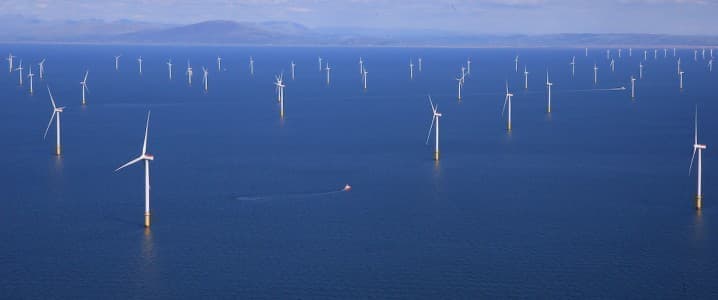South Korea might be reputed for its state-of-the-art condensate splitters or for its massive LNG appetite that has propelled it to the ranks of the world’s third-largest importer, yet from now on it might be closely associated with wind energy. In February 2021 the South Korean government announced that it intends to build the world’s largest wind farm in the Sinan region (South Jeolla), the 8.2 GW capacity of which will surpass the largest wind plant currently in operation (Hornsea off the English coast, 1.2 GW) by a factor of seven. The monster wind project brings together most South Korean private energy companies, encompassing all relevant segments – turbine producers, plant operators and utility firms – yet even so, is it feasible at all?
The slated capacity of the monster wind park will not come onstream at once, its commissioning is split into 3 phases. Phase I is assumed to start straightaway in 2021 and end in 2025, bringing 4.1GW into South Korea’s electricity production matrix. Phase II (2022-2027) and Phase III (2024-2030) both wield a 2.1GW capacity. The ceremonial signing of the project’s project charter was attended by all leading South Korean energy companies, ranging from generation companies (KEPCO, SK) to wind turbine producers (CS Wind, Doosan Heavy Industries). Seemingly, some companies will take on larger roles than others, for instance Hanwha will not only be part of the tripartite project development but will also supervise procurement and construction. In total 33 companies have signed up to the preliminary agreement and will provide 98% of project financing. Related: Saudi Surprise Cut May Have Lasting Effect On Oil Prices
When President Moon Jae-in addressed the crowd on the issue of the Sinan wind park in early February, he accentuated that its total capacity will be equivalent to 6 nuclear plants and with this the entire cities of Seoul and Incheon could be kept alight. Promising that the Sinan wind farm will create 120 000 jobs, the President has failed to note that it still needs to get a final investment decision. A lot will depend on buyer’s interest for the electricity to be generated by the monster project, according to South Korean authorities Phase I capacities are preliminarily allocated amongst relevant companies, with KEPCO taking the prime with an assumed allotment of 1.6GW, followed by SM and Neulsam who both have signed up for 0.6GW.
For this to happen, Seoul would need to prepare an adequate legislative background. First point on the agenda should be the Electricity Business Act, the amendment of which is expected to take place at some point in 2021. Under the current legislative norms, KEPCO is barred from participating in power generation and contents itself with the latter half of the generation stream, i.e. transmission and sales. It is assumed that the state-owned KEPCO would take a leading role in the Sinan wind farm, hence the amendment of the bill seems a sine qua non condition for its successful roll-out. Thus, optimizing the Sinan wind farm would be a double whammy of aligning the interests of KEPCO and smaller retailers, whilst at the same time domestically boosting equipment production capacities and localizing missing technological links.
Cognizant of its environmentally problematic energy utilization patterns, the South Korean government has launched its own Green Bill last summer. The overarching national commitment is to go carbon-neutral by 2050, using a plethora of methods to this end, ranging from reforestation (including urban forests) and recycling to the promotion of renewables. In terms of Seoul’s mid-term ambition is to bring 32GW of solar and 12GW of wind capacity online by 2030. Solar energy has seen the most substantial growth amongst renewables, with total capacity doubling within just 3 years from 5GW in 2017 to 10.5GW in 2020.
Related Video: The Climate Change Bankers, For Better or Worse
Any domestically produced energy would be preferred to importing fossil fuels, be it coal, oil or natural gas (the three making up roughly 85% of South Korea’s primary energy consumption). In the current constellation, coal is the most likely candidate to suffer from the forthcoming blasts of wind energy. The utilization of coal energy is the least popular means of energy generation amongst the South Korean populace and the government anyways curtails its utilization in wintertime so as to decrease the likelihood of smog taking over the streets of Seoul. The 2020 Green Bill already commits to a halt in overseas coal investments; however, it has stopped short of introducing stringent domestic directives with regard to coal utilization. On top of it all, South Korea’s coal capacity still hasn’t peaked (assumed to take place around 2024/2025, around 39GW).
The main problem with South Korea’s renewables targets in general and the Sinan wind farm specifically is that they understate the importance of fossil fuels within its economy. With Seoul’s gradual nuclear phaseout remaining in vigor (amounting to the closure of 10 nuclear reactors in the next 9 years, not a total phaseout), South Korea would still need non-intermittent baseload power. The fact that South Korean firms are retrofitting currently coal-burning plants to LNG (moreover, every coal plants that would turn 30 years old in the 2024-2034 timeframe would be mandated to do the switch) only corroborates the assumption that natural gas will be the biggest immediate winner of its Green Bill. The Sinan wind farm is by no means infeasible, far from it. The problem is that with its commissioning, the progressive pro-renewables zeal of South Korean firms might fizzle out.
By Viktor Katona for Oilprice.com
More Top Reads From Oilprice.com:
- Oil Falls After Spiking Due To Missile Attack On Saudi Tank Farm
- Oil Soars As OPEC+ Sources Suggest No Production Increase
- $70 Oil May Cause Slowdown In Demand Recovery


















